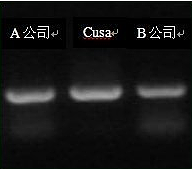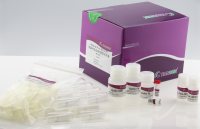Microscale Hot Borate RNA Extraction from Cotton Tissue--从棉花组织中提取微量RNA
互联网
Prior to Extractions
・ Bake all necessary glassware, metal spatulas, mortars, and pestles overnight in a 200℃ oven after wrapping them in aluminum foil. For each sample, you should minimally prepare one mortar and pestle, one homogenizer and one spatula.
・ DEPC-treat a sufficient volume of water for all dilutions (500 mL is usually plenty).
・ Prepare all reagents and solutions.
Day 1
- Place all mortars to be used in liquid nitrogen to cool. Heat homogenizers to 65℃ and acquire dry ice. After the mortars are cooled, nestle them in the dry ice.
- Collect 1 g of tissue and flash freeze in liquid nitrogen.
- Transfer to a cooled mortar and pestle. Grind tissue in liquid nitrogen until it is a fine powder.
- Remove one pre-warmed glass homogenizer. Add 8 mL of the 85℃ XT buffer and 10 µL of Proteinase K solution (10 mg/mL). Transfer the frozen, ground sample to the warm XT buffer and grind thoroughly until the suspension is evenly dispersed.
- Transfer homogenate to a labeled 50 ml Oakridge tube. Mix and incubate for 1.5 hours in the 42℃ incubator/shaker.
- Remove from incubation. Add 1040 µL of 2M potassium chloride (for a final concentration of 160 mM; this step will precipitate proteins from the extract). Gently vortex to mix. Incubate on ice for 1 hour.
- Centrifuge at 5000 rpm for 20 minutes at 4℃ to remove debris.
- Transfer the supernatants to new, labeled 50ml Oakridge tubes.
- Add 1/3 volume of 8M lithium chloride (making a final concentration of 2M). Incubate on ice overnight.
Day 2
- Place tubes in the pre-chilled centrifuge and chilled rotor. Spin at 10,000 rpm (12,000 g) for 20 minutes at 4℃. Decant and discard supernatant.
- Wash pellet in 1.5 mL of ice-cold 2M lithium chloride. Disperse pellet with a sterile disposable pipette (as needed) after adding the lithium chloride. This will minimize the retention of unwanted substances.
- Centrifuge tubes at 10,000 rpm (12,000 g) for 15 minutes at 4℃. Decant and discard supernatant.
- Repeat steps 2 & 3 twice more. Spin for 6 minutes.
- Suspend pellet in 250 µL of 1X TE, ph 8.0 and gently vortex. The sample may be warmed to room temperature to facilitate diffusion.
- Remove the insoluble material by centrifuging tubes at 10,000 rpm (12,000 g) for 10 minutes at 4℃.
- Save the supernatant and transfer it to pre-labeled 1.5 mL microcentrifuge Eppendorf tubes. Add 1/10 volume (about 28 µl) of 2 M potassium acetate (pH 5.5). Incubate on ice for 15 minutes. This will removed positively-charged polysaccharides, residual proteins, and other salt-insoluble material.
- Centrifuge tubes at 10,000 rpm (12,000 g) for 15 minutes at 4℃. Discard pellet by transferring supernatant to a new tube.
- Precipitate RNAwith 1/10 volume (about 31 µL) of 3 M sodium acetate (pH 6.0) and 2.5X volume (about 875 µL) of cold 100% ethanol. Store at -80℃ for 1-2 hours.
- Centrifuge at 13,000 rpm for 20 minutes at 4℃ to collect RNA. Remove ethanol and discard. Wash with 1 mL of 70% ethanol. Centrifuge for 5 minutes at 4℃. Aspire or pipette off the ethanol.
- Resuspend RNA in 100 µL of DEPC-treated water and store at -80℃. Alternatively: To assess the quality of the DNA, prepare a 1% agarose gel (0.30 g agarose in 30 mL 1X TAE buffer). Load 1 µL of each RNAsample into each well after mixing the aliquot with fast orange tracking dye. Run a ladder in one lane. The gel should be electrophoresed at 40-50 volts, stained in ethidium bromide, and visualized under an ultraviolet light source. For even clearer gels, use the formaldehyde electrophoresis protocol.
More Info :
- This procedure has produced decent yields of RNAfrom cotton tissues, a genus that does not easily yield nucleic acids due to polysaccharides, phenolics, etc.
- Yield is approximately 100-500 µg/g tissue.
- Yield results are best using cotyledons, mid-range for leaves and whole ovules, and low for fibers. Typical results are given in the table below.
Sample Tissue | Mass | |||
A2 leaves | 0.3 g | 1.898 | 97 | 322 |
A2 cotyledons | 0.3 g | 1.910 | 125 | 417 |
D5 leaves | 0.3 g | 1.800 | 48 | 160 |
D5 ovules, 10 dpa | 0.3 g | 1.750 | 89 | 222 |
D5 ovules, 20dpa | 0.4 g | 1.813 | 33 | 82.5 |
AD3 ovules | 0.23g | 1.968 | 115 | 500 |
Reagents and Solutions
DEPC-Treated Water
< !> Perform all these steps under a fume hood!
Add 0.05% (v/v) DEPC to the required volume of distilled, deionized water (for example, 500 mL of water requires the addition of 250µL DEPC). Mix by vigorous stirring for approximately 30 minutes. Autoclave to break down the DEPC.
Hot Borate Extraction Buffer (XT Buffer)
Absolute For 100 mL
0.2M Borax (Sodium-borate decahydrate) 7.63 grams
30 mM EGTA 1.14 grams
1% (w/v) SDS 1.0 gram
1% sodium deoxycholic acid (deoxycholate, sodium salt) 1.0 gram
For 38ml aliquot of XT Buffer:
DTT 0.6g
PVP 0.73g
IGEPAL 360µl
Proteinase K (10 mg/mL in DEPC-treated dd-water; store stock at -20℃)
1X TE (10 mM Tris-Hcl, pH 7.5 with 1 mM EDTA, pH 8.0)
2 M Potassium chloride
2 M Potassium acetate, pH 5.5
2 mM AND 8 mM Lithium chloride (keep in refrigerator)
3 M Sodium acetate, pH 6.0
Ethanol, 70% and 100% (keep at -20℃)
Liquid nitrogen (for tissue grinding)
Time Estimates (For Four Different Samples)
Day 1 procedure takes 4 hours, including incubations, the first time you perform the procedure.
Day 2 steps #13-20 require 2 hours, including all spins. Step #21 is a two-hour incubation. Steps #22-23 take about 1 ½ hours to complete, depending on the method you use to remove the ethanol washes.









